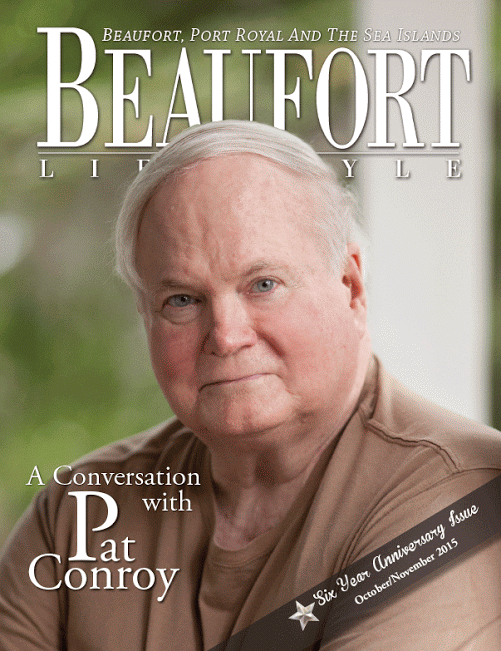A conversation with Pat Conroy
story by mary ellen thompson photography by john wollwerth
We think of Pat Conroy as not only a writer, but really, one of the
greatest of Southern writers. And he is. Which of us has not read at
least one of his books? But the true greatness of Pat Conroy extends
so very far beyond the reach of his words. As bedazzling as the rich
complexity of the use of language in his novels is, the stories he
intersperses in his non-fiction books and blog are the ones that give
you the sense of the man, his humanity that has risen over the wounds
of his childhood. The amazing boundlessness of his empathy, courage,
and arcs of friendships are the finest tributes imaginable to the
legions of people with whose lives he has intersected.
Reading a Pat Conroy novel is like being lashed to a mast, and
sailing into a story that surrounds you like a blanket of fog. Your
primary senses are dulled to anything but the rhetoric and where it
will take you; yet in the vast distance you can still sense shrapnel
shooting by as the stars of his language explode around you.
Talking with Pat is like facing an immense buffet and trying to
choose just what will fit on your plate. We talked about food,
exercise, books and some of the characters he’s met along the way. So,
come and join us, sit down, eavesdrop on our conversation.
Since food is a legendary affection for Pat, I wondered if his
decision to spend time at the gym and get in better shape affected the
way he now cooks, and if his cookbook was actually just a masquerade
to have a book of short stories.
Pat said, “We all know what we should eat, what’s healthy; I
wrote that cookbook for people who were trying to speed up the dying
process. If there was a just and merciful God, a dry martini would
have one calorie and a bean sprout would have three thousand.
“In the cookbook are the stories I’d written but not published, I
wrote and re-wrote them. I loved writing it – no one died, no one was
beaten.”
We discussed the particular nature of inflicting pain personal
trainers have; Pat agreed, “I’m working out five times a week and
something new always hurts; Mina finds ways to torture me.”
In his cookbook, Pat comments about his aversion to cilantro
which is a feeling I share. I wondered how he felt about tilapia,
which I think became popular on menus at about the same time.
Pat’s take? “People look at me like I’m crazy when I say I don’t
like cilantro; they tell me to try it fresh, or dried or just out of
the garden. I’ve tried it all those ways; it tastes like soap and I
just don’t like it. Tilapia? I can’t even figure out what tilapia is.”
I love the stories Pat tells in the cookbook about the times he
unwittingly met some very famous chefs. My favorite was the night Nan
Talese was taking him out to dinner to celebrate the launch of The
Prince of Tides. She didn’t realize that the restaurant didn’t take
credit cards and tried to give the owner/chef her gold bracelets to
hold while she went back to the hotel for money, and he wouldn’t even
consider it. Years later Pat saw him on television and realized it was
Emeril Lagasse.
Pat laughed at the memory, “Nan was wearing an armful of
bracelets that were worth a small fortune. I wished I’d had the money
to give to him and I could have kept the bracelets! I told her she
should have published his first cookbook, but she still thinks he was
a dreadful man that night.”
Since a conversation with Pat can round more corners than a
NASCAR race, it doesn’t seem strange that we came to the matter of
snakes. He wrote, “My mother, who was no stranger to wildlife,
collected poisonous snakes and once told me that a copperhead I caught
her for Mother’s Day when she was pregnant with my brother Jim was the
most thoughtful present she had ever received.” I wondered if that
seemed out of the ordinary to him.
Pat shook his head, “Not to us, she was the only mother we ever
had. I like snakes; I know many people don’t, my wife is terrified of
them. Mom would get all of us kids banging pots and pans while she
went to the other side of the woods and wait for us to scare the
snakes out. She would pick them up, she’d pick up a rattlesnake. We
all talked about it later and thought it was because she came from a
town in Alabama that was rife with snake handling fundamentalists.”
If you’ve read any of Conroy, you know that his mother’s favorite
book of all time was Gone with the Wind, and her great love of the
book had a profound influence on his life. He was invited by Margaret
Mitchell’s heirs to write a sequel but the negotiations and conditions
imposed proved too overwhelming and stringent. Because that book had
such an impact on him, I wanted to know if he was disappointed that he
didn’t get to write the sequel. Did he have a strategy for Rhett?
With a sigh, Pat replied, “I couldn’t deal with what they wanted.
I wanted to write it because I wanted to dedicate it to my mother. I
had some good ideas; it would have been the autobiography of Rhett
Butler. I had a plan for Rhett – he was from Charleston, he would have
gone to the Citadel.”
Pat, I asked, in Why I Write, you say “My well-used dictionaries
and thesauri sing out to me when I write, and all English words are
the plainsong of my many-tongued, long-winded ancestors who spoke
before me.” I was tickled to see you used “meretricious” twice in
Beach Music; are you still a thesaurus user, or after your keeping
long lists of words, is your vocabulary now sufficient unto itself?
Pat handed me one of the brown, well worn, leather bound journals
that tie with a string of rawhide, and on the left hand pages were
penned, in brown ink, lists of unusual words written in beautiful, and
very tiny, script.
He told me, “Sure I still use it, and I keep notebooks. I make a
list down the side of the page so the words can inspire me. Language
fires me up.”
When friends heard I was going to write this story, they asked if
I could incorporate some of their questions and Pat was gracious
enough to field them.
Susan: I’d ask him how he finds the courage to be so raw and revealing
in his writing.
Pat: “It was an accident at first, I didn’t realize how many people
would be hurt.
When I wrote The Boo, it was the The Citadel, they banned the
book. The Water is Wide hurt the city of Beaufort. The Great Santini
hurt my entire family. But if I didn’t tell the truth the way I saw
it, I wasn’t worth anything as a writer.”
Cindy: If you hadn’t found literature, what do you think would have
become of your life?
Pat: “I loved teaching. One of the two years I’ve never written about
were the two years I taught at Beaufort High School. I don’t think I
was a very good teacher, but I loved teaching. I think I would have
gotten good at it, but after Daufuskie no one would hire me to teach
so it was a good thing that I liked writing.”
Pierce: Ask him how he came up with the off-the-wall idea of putting a
tiger in The Prince of Tides.
Pat: “Happy the Tiger was in a cage at a gas station in Columbia, SC;
I went there to get gas so I could see him. If you bought gas, you got
a free car wash and while the car was being washed, you got to throw a
chicken neck to the tiger. He was mean as hell, he probably didn’t
like being in a cage outside in the hot South Carolina sun. They
eventually built the zoo in Columbia so that tiger had a place to go.
“I was living in Rome, the story was in trouble, it had rapists
and murderers and I didn’t know what to do with them. I was out to
dinner one night when I saw a woman in the restaurant and half of her
arm was missing. So I asked her what happened. She had seen a man
abusing a tiger at the zoo and wanted to help so she stepped in, and
the tiger ripped her arm off. I thought to myself, well I have a tiger
in a barn back there, so that’s how he came into the story.”
Steve: How do you know when the end of a story has come, and have any
of your characters wanted a sequel?
Pat: “I can feel it coming. In my stories people have been through
hell and back; it’s time to let them go off into their fictional
world.
“When I wrote The Great Santini, I planned to have Ben Meecham be
the main character in The Lords of Discipline, then to have Ben go
through his life as the main character of several of the books, but
after the movie was made, Hollywood would have owned rights to all
those books if Ben was part of them. So I had to change my plan, but
it loosened me up.”
Elizabeth: How do you know where to start a book?
Pat: “Usually I don’t. Usually it is fizzling around and it starts
with the prologue. When I’m finished with the prologue, I can begin in
earnest on the novel.
In The Great Santini it was – why did I hate my father? In The
Lords of Discipline – why I hated the plebe system. In The Prince of
Tides – why did my sister go crazy?”
After our lovely afternoon I just hugged Pat Conroy, I wanted to
thank him with all my heart for all he’s done for literature and the
truest art of story telling. Not only are his books exquisite in their
mastery, but they have followed the course of his amazing life. I’m
hard pressed to choose between the great descriptive language in his
novels, and the stories themselves in the collections. If you’ve
missed reading any of them, get yourselves to the Pat Conroy at 70
festival, say hello to Pat, buy several of the many author’s books and
get them signed!



